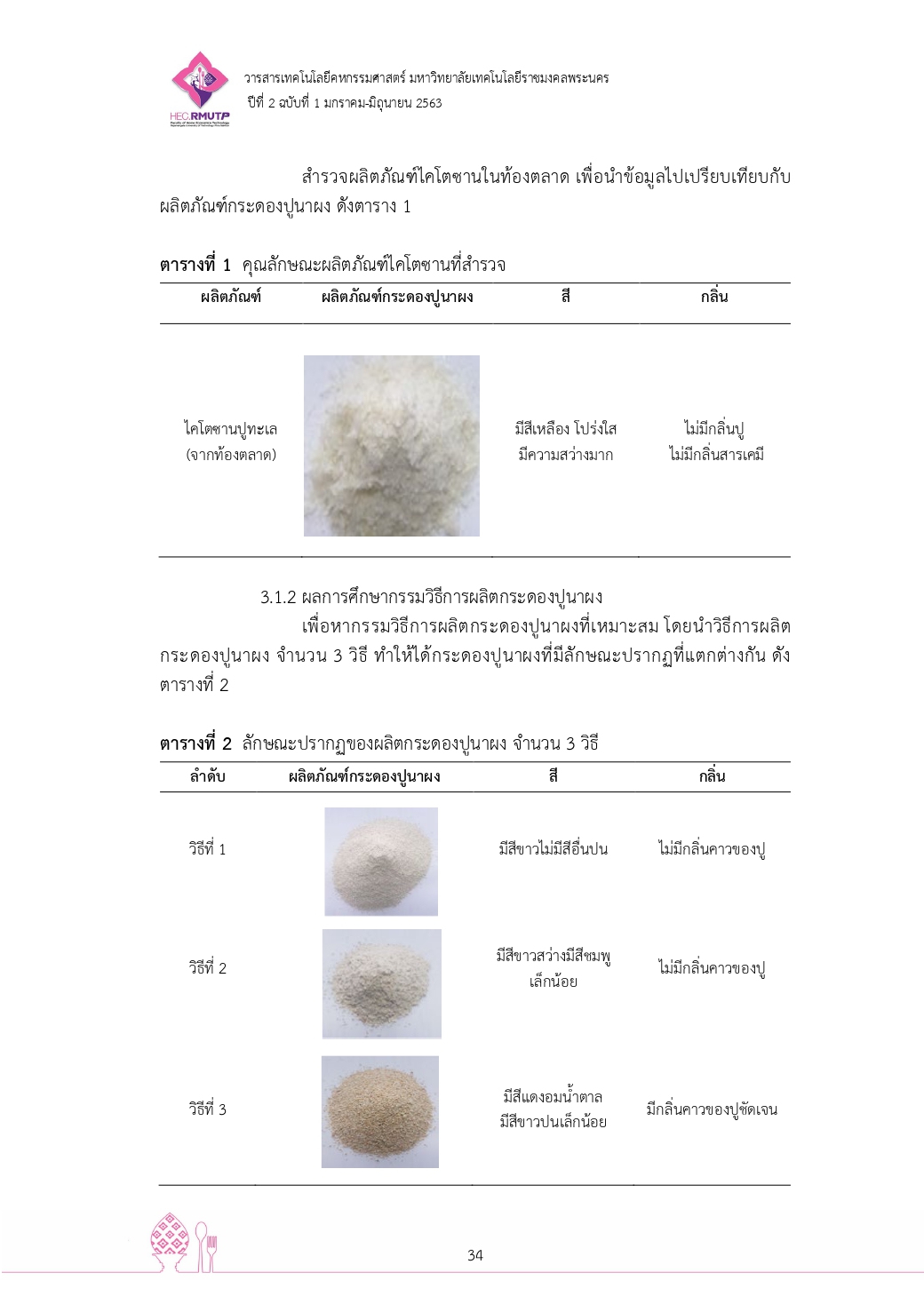การศึกษากรรมวิธีการผลิตกระดองปูนาผง
Main Article Content
บทคัดย่อ
การศึกษากรรมวิธีการผลิตกระดองปูนาผง มีวัตถุประสงค์เพื่อศึกษากรรมวิธีการผลิตทั้ง 3 วิธีพบว่าวิธีที่ 1 (ปูอบแช่สาร) ใช้ระยะเวลาในการแช่สารและต้มกระดองปูนาในสารโซเดียมไฮดรอกไซด์ น้อยกว่าวิธีที่ 2 (ปูต้มแช่สาร) ส่วนในวิธีที่ 3 (ปูอบ) ไม่มีการเติมสารเคมีและกำจัดสารอินทรีย์ ทำให้ยังคงมีสารอินทรีย์หลงเหลือเป็นจำนวนมาก จากนั้นนำกระดองปูนาทั้ง 3 วิธี ไปศึกษาคุณสมบัติทางกายภาพ พบว่า วิธีที่ 1 ค่าสี L*, a*, b* มีค่าเท่ากับ 42.34± 0.18, 9.23 ± 0.03 และ 10.23 ± 0.05 ตามลำดับ มีสีขาว ไม่มีความโปร่งใส และ aw น้อยที่สุด เมื่อนำมาเปรียบเทียบกับไคโตซานปูทะเล พบว่าทั้ง 3 วิธีแตกต่างจากไคโตซานปูทะเลและค่าความหนืด วิธีที่ 2 มีค่ามากที่สุด ส่วนคุณสมบัติทางเคมีตรวจ โดยใช้เครื่อง ED-XRF พบว่า ได้ค่าแคลเซียมทั้ง 3 วิธี มีค่าเท่ากับ 98.248, 99.278 และ 99.727 ตามลำดับ โดยทั้ง 3 วิธี มีค่าแคลเซียมอยู่ในช่วงที่ใกล้เคียงกัน แต่วิธีที่ 1 มีความบริสุทธิ์ของแคลเซียมมากกว่าจากกรรมวิธีการผลิต และเมื่อตรวจโครงสร้างโมเลกุล ด้วยเครื่อง FT-IR เปรียบเทียบกับไคโตซานทะเล พบว่า กระดองปูนาผงที่ได้ทำการทดสอบทั้ง 3 วิธี ไม่พบเลขคลื่นโครงสร้างโมเลกุลของไคโตซาน ส่วนค่าปริมาณความชื้น, โปรตีน และไขมัน วิธีที่ 1 มีค่าน้อยที่สุด และค่าปริมาณเส้นใยหยาบทั้งหมดมีค่ามากที่สุด หลังจากนั้นนำไปศึกษาอายุการเก็บรักษาของกระดองปูนา พบว่า กระดองปูนาวิธีที่ 1 และ 2 สามารถเก็บรักษาได้อย่างน้อย 2 สัปดาห์ แต่วิธีที่ 3 สามารถเก็บรักษาได้อย่างน้อย 1 สัปดาห์
Article Details
เอกสารอ้างอิง
ปภาวดี ทองคำ และปราริชาติ เพชรมีดี. 2556. การสกัดไคโตซานจากเปลือกปู. สาขาวิศวกรรมแปรรูปอาหาร. คณะอุตสาหกรรมเกษตร. สถาบันเทคโนโลยีพระจอมเกล้าเจ้าคุณทหารลาดกระบัง, กรุงเทพมหานคร.
ประภัสสร บัวนาค, สุวรรณี สารภาค และไพลิน เต่าคำ. 2561. การสกัดไคตินและไคโตซานจากกระดองปูนาที่มีผลต่อการคงสภาพของมะเขือเทศ. สาขาวิชาเคมี. คณะวิทยาศาสตร์และเทคโนโลยี. มหาวิทยาลัยราชภัฏสุรินทร์, สุรินทร์.
รุ่งนภา พงศ์สวัสดิ์มานิต และไพศาล วุฒิจำนง. 2545. การประเมินอายุการเก็บรักษาผลิตภัณฑอ์ าหาร. เอกสารประกอบการสัมมนา-อบรมวิชาการด้านอุตสาหกรรมอาหาร
สถาบันปิโตรเลียมแห่งประเทศไทย. 2554. เส้นใยจากเปลือกกงุ้ และกระดองปูใช้เป็นวัสดุในการผลิตชิ้นส่วนสำหรับรถยนต์. [ออนไลน์]. เข้าถึงได้จาก http://plastic.oie.go.th/, 1 กุมภาพันธ์ 2563.
สุภวรรณ ฏิระวณิชย์กุล, สลิลลา ชาญเชี่ยว และยุทธนา ฏิระวณิชย์กุล. 2556. การอบแห้งใบบัวบกเพื่อผลิตใบบัวบกแห้งชงดื่มด้วยการแผ่รังสีอินฟราเรดจลนพลศาสตร์ ความสิ้นเปลืองพลังงานและคุณภาพ. ภาควิชาวิศวกรรมเคมี. คณะวิศวกรรมศาสตร์. มหาวิทยาลัยสงขลานครินทร์, สงขลา.
สุธีรา ขันทพันธ์ และสุธิดา อัครชะนียากร. 2560. การศึกษาเปรียบเทียบสมบัติของไคโตซานโดยใช้เปลือกกุ้งดิบและเปลือกกุ้งสุกเป็นวัตถุดิบ และการใช้เป็นสารตะกอนนํ้าแอปเปิ้ล. ภาควิชาเทคโนโลยีอุตสาหกรรมเกษตรอาหารและสิ่งแวดล้อม คณะวิทยาศาสตร์ประยุกต์มหาวิทยาลัยเทคโนโลยีพระจอมเกล้าพระนครเหนือ, กรุงเทพมหานคร.


